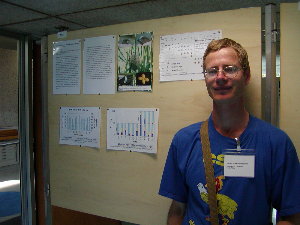 WeaveResearch Unit
WeaveResearch Unit
 WeaveResearch Unit
WeaveResearch Unit |
Weavers of the World |
| Home | Site map | Weavers of the World | Weaver Watch | Weaver Research Unit |
Polygyny and breeding activities in Thickbilled Weavers Amblyospiza albifrons
Poster presented at the Third Conference of the European Ornithologists' Union, 21-15 August 2001, Haren/Groningen, The Netherlands
Read more about the ADU's attendance at the EOU
Abstract
Although the Thickbilled Weaver Amblyospiza albifrons has a wide distribution in Africa, it has been poorly studied. It is sexually dimorphic, and breeds in reeds. The male builds the nest and the female incubates the eggs and feeds the chicks. There is uncertainty about the mating system of this species: some authors consider it mainly monogamous while others consider it polygamous. Evidence is given here of polygyny; it may at times appear to be monogamous due to having a low rate of polygyny. Male activities and female incubation bouts were recorded in one colony at the National Botanical Gardens in Pretoria, South Africa. The Thickbilled Weaver has expanded its range to Gauteng in the 1960s, and has been breeding in the Botanical Gardens since at least 1989. In the 1997-98 season, breeding began in August 1997 and continued until at least January 1998. The colony initially consisted of one male, and later in the season a second male joined the colony. Male 1 mated with six females successively, while Male 2 mated with one, or possibly two, females. The maximum number of nests of one male with active contents at one time was three. Seven clutches consisted of three eggs, and one of four eggs. Eight females were observed with complete clutches and the combined incubation attentiveness during the day was 73%. Incubation bouts of complete clutches averaged 33 minutes in the nest and 13 minutes out. The most frequent activities of males in the colonies were nest-building and perching. The two males often built nests at the same time, giving rise to similar proportions of time spent on this; no synchrony of other activities was observed. On two occasions a male was seen to feed nestlings, a previously unrecorded observation in this species.

Poster text (figures not available here)
Although the Thickbilled Weaver Amblyospiza albifrons has a wide distribution in Africa, it has been poorly studied. It is sexually dimorphic, and breeds in reeds (Fig. 1). The male builds the nest and the female incubates the eggs and feeds the chicks. There is uncertainty about the mating system of this species: some authors consider it mainly monogamous while others consider it polygamous. Evidence is given here of polygyny; it may at times appear to be monogamous due to having a low rate of polygyny. The Thickbilled Weaver has expanded its range to Gauteng in the 1960s, and has been breeding in the National Botanical Gardens in Pretoria, South Africa, since at least 1989. Three colonies, but particularly Colony 1, in the Botanical Gardens were observed during the 1997-98 season. Breeding began in August 1997 and continued until at least January 1998. Male activities were recorded every minute and female incubation bouts were recorded individually. Colony 1 initially consisted of one male, and later in the season a second male joined the colony. Male 1 mated with six females successively (Fig. 2), while Male 2 mated with one, or possibly two, females. The maximum number of nests of one male with active contents at one time was three (Nests occupied by females 53, 56. 72 in Fig. 2).
Seven clutches consisted of three eggs, and one of four eggs. Seven females in the three colonies were observed with complete clutches. Incubation bouts in the nest varied widely from 9 to 64 minutes (average per female), while bouts out of the nest varied less at 7 to 19 minutes (Fig. 3). The overall average was 33.4 minutes in the nest and 12.6 minutes out of the nest, giving an attentiveness (= time in nest *100 / total time) of 72.7%. The most frequent activities of males in the colonies were nest-building and perching. Activities were divided into several categories but lumped into four main categories for comparison (Fig. 4). The two males often built nests at the same time, giving rise to similar proportions of time spent on this; no synchrony of other activities was observed. On two occasions a male was seen to feed nestlings, a previously unrecorded observation in this species. Polygynous weavers are expected to spend much time at their nests to display. While much time was spent away from the colony by Thick-billed Weavers, other aspects of its breeding biology favour polygyny: only the male builds the nest, the male builds more nests than are needed, the male displays from the nest (or near the nest), the male never incubates, the male very rarely helps feed the chicks.
